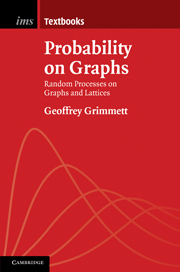Book contents
- Frontmatter
- Contents
- Preface
- 1 Random walks on graphs
- 2 Uniform spanning tree
- 3 Percolation and self-avoiding walk
- 4 Association and influence
- 5 Further percolation
- 6 Contact process
- 7 Gibbs states
- 8 Random-cluster model
- 9 Quantum Ising model
- 10 Interacting particle systems
- 11 Random graphs
- 12 Lorentz gas
- References
- Index
11 - Random graphs
Published online by Cambridge University Press: 05 June 2012
- Frontmatter
- Contents
- Preface
- 1 Random walks on graphs
- 2 Uniform spanning tree
- 3 Percolation and self-avoiding walk
- 4 Association and influence
- 5 Further percolation
- 6 Contact process
- 7 Gibbs states
- 8 Random-cluster model
- 9 Quantum Ising model
- 10 Interacting particle systems
- 11 Random graphs
- 12 Lorentz gas
- References
- Index
Summary
In the Erdős–Rényi random graph Gn,p, each pair of vertices is connected by an edge with probability p. We describe the emergence of the giant component when pn ≈ 1, and identify the density of this component as the survival probability of a Poisson branching process. The Hoeffding inequality may be used to show that, for constant p, the chromatic number of Gn,p is asymptotic to ½ n/logπn, where π = 1/(1 – p).
Erdős–Rényi graphs
Let V = {1, 2, …, n}, and let (Xi,j : 1 ≤ i < j ≤ n) be independent Bernoulli random variables with parameter p. For each pair i < j, we place an edge 〈i, j〉 between vertices i and j if and only if Xi,j = 1. The resulting random graph is named after Erdős and Rényi, and it is commonly denoted Gn,p. The density p of edges may vary with n, for example, p = λ/n with λ ∈ (0, ∞), and one commonly considers the structure of Gn,p in the limit as n → ∞.
The original motivation for studying Gn,p was to understand the properties of ‘typical’ graphs. This is in contrast to the study of ‘extremal’ graphs, although it may be noted that random graphs have on occasion manifested properties more extreme than graphs obtained by more constructive means.
Random graphs have proved an important tool in the study of the ‘typical’ runtime of algorithms.
- Type
- Chapter
- Information
- Probability on GraphsRandom Processes on Graphs and Lattices, pp. 205 - 218Publisher: Cambridge University PressPrint publication year: 2010
- 17
- Cited by

